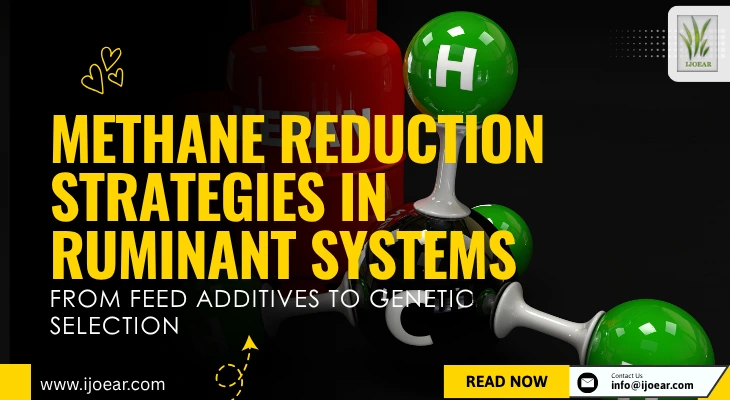
Methane (CH₄), though far less abundant than carbon dioxide (CO₂), has a much higher global warming potential—about 28 times greater over 100 years and up to 84 times higher in the first 20 years after release. Despite its shorter atmospheric lifespan of 10–12 years, methane remains a short-lived but highly potent climate pollutant, offering one of the fastest routes to slowing global warming.
Significant reductions in methane emissions could provide immediate climate benefits while also improving livestock productivity, feed efficiency, and food security. Around 40% of anthropogenic methane emissions come from agriculture—particularly from livestock systems, where enteric fermentation alone contributes nearly 90 teragrams (Tg) of methane annually. With manure management adding another 25 Tg, the livestock sector collectively represents a major mitigation opportunity.
Organizations like the Intergovernmental Panel on Climate Change (IPCC) and the United Nations Environment Programme (UNEP) have emphasized that methane emissions must decline by 30–60% of 2020 levels by 2030 to align with the Paris Agreement's 1.5°C target. For the livestock sector specifically, modeling suggests methane reductions of 11–30% by 2030 and up to 47% by 2050 are needed to stabilize global temperatures. However, achieving these goals is complex due to the rising global demand for meat and dairy, especially in developing economies. Therefore, a comprehensive mitigation strategy combining feed innovations, breeding technologies, and precision monitoring is critical.
Methane mitigation isn't just about the environment—it also delivers direct economic and productivity benefits. Because methane represents a loss of feed energy (up to 12% of total intake), reducing emissions means better feed utilization and enhanced animal growth rates.
Moreover, the shorter atmospheric lifespan of methane means that reductions lead to rapid climate improvements, unlike CO₂ which lingers for centuries. Many reduction strategies, such as feed-based additives or genetic selection, simultaneously improve animal health, productivity, and energy efficiency—creating a win-win scenario for farmers and the planet.
These innovations also contribute to a circular agricultural economy, where captured methane is repurposed for biogas energy and organic fertilizer, adding both environmental and economic value.
One of the most immediate and effective ways to reduce enteric methane is through dietary modification. Feed-based interventions alter rumen fermentation pathways, microbial populations, and hydrogen flow—directly influencing methane output.
The synthetic compound 3-nitrooxypropanol (3-NOP), commercially available as Bovaer®, inhibits the enzyme responsible for methane formation in the rumen. Multiple studies have shown 30–40% methane reduction in dairy and beef cattle, without negative impacts on feed intake or productivity. 3-NOP is particularly promising for confined and feedlot systems, where feed intake can be tightly controlled.
Phytochemicals such as tannins, saponins, flavonoids, garlic extracts, and citrus oils can alter rumen microbial ecology, decreasing methane-producing archaea. While reductions vary with dosage and diet, these natural alternatives have appeal in low-input and organic systems.
Adding unsaturated fats or oils reduces methane by redirecting hydrogen away from methanogenesis. However, high-fat diets can impair fiber digestion, so balancing energy and digestibility remains key.
Among the most revolutionary discoveries is Asparagopsis taxiformis, a red seaweed containing bromoform, a compound that suppresses methane-producing enzymes. Trials show 70–98% emission reductions with inclusion rates as low as 0.2–0.5% of the diet. The main challenge lies in scaling up sustainable seaweed cultivation and ensuring feed safety. Companies like FutureFeed are pioneering commercialization of this innovation.
While feed strategies offer quick results, genetic selection and microbiome optimization provide long-term, cumulative benefits.
Enteric methane production shows moderate heritability (0.11–0.33) in cattle and even higher in sheep. This opens the door for selective breeding programs that favor low-emission, high-efficiency animals. Initiatives like RuminOmics, the Global Research Alliance, and the Animal Selection, Genetics, and Genomics Network (ASGGN) are integrating methane traits into breeding indices.
The rumen microbiome—a complex community of bacteria, archaea, and protozoa—plays a central role in methane production. Emerging research focuses on microbiome modulation through probiotics, microbial transplants, or precision feed interventions to cultivate low-methane microbial populations.
Advanced genomic prediction tools such as GBLUP (Genomic Best Linear Unbiased Prediction) combine genetic and microbial data to predict methane emissions and feed efficiency with higher accuracy. These approaches make data-driven breeding for methane reduction increasingly feasible across livestock systems. This represents a key application of AI in agricultural innovation.
Accurate measurement of methane emissions is crucial for both scientific validation and management decisions. Traditional "sniffer" systems or respiration chambers, while effective, are limited in scalability.
Recent innovations like SCOUT, an in-vivo methane sensor, have revolutionized the field. SCOUT captures up to 82% data retention, enabling continuous, high-resolution monitoring of emissions directly from animals.
Another cutting-edge development is GasTwinFormer, an AI-powered optical gas imaging tool that detects and classifies methane emissions based on diet and management practices in real-time. Together, these systems are paving the way for precision livestock farming, where emission tracking supports breeding, feeding, and management optimization at the farm level.
While enteric fermentation accounts for the majority of livestock methane, manure management is another critical component of the emission cycle. Methane forms under anaerobic (oxygen-deprived) conditions, which are common in slurry pits and lagoons.
These systems capture methane and convert it into biogas, a renewable energy source. The digestate left behind serves as a nutrient-rich organic fertilizer.
Covering manure lagoons and introducing aerobic decomposition dramatically reduce methane formation.
Composting accelerates organic matter breakdown under aerobic conditions, further minimizing methane output.
A strong example is India's Gobar Dhan Scheme, which promotes biogas production from cattle waste, demonstrating how circular economy approaches can reduce emissions, create energy, and support rural livelihoods simultaneously.
Despite significant technological progress, global implementation remains uneven. According to a 2025 report by Changing Markets, only Danone and Nestlé among 20 leading dairy corporations had methane-specific reduction targets. This indicates a serious accountability gap in the livestock industry.
Meanwhile, countries like Brazil—the world's largest beef exporter—have seen methane emissions increase by 6% between 2020 and 2023, with cattle contributing nearly 14.5 million tons of methane, equivalent to 406 million tons of CO₂-equivalent—more than Italy's total greenhouse gas emissions. Experts argue that through better feed, genetic selection, and earlier slaughter ages, Brazil alone could cut livestock methane emissions by 25% by 2035. This underscores the urgent need for stronger policy frameworks, incentives, and corporate commitments toward emission reduction.
No single strategy can achieve the ambitious methane reduction targets alone. A multi-pronged approach combining short-term feed additives, medium-term management improvements, and long-term genetic and microbiome interventions offers the best chance of success.
An ideal strategy could integrate:
Such integrated systems align with both climate goals and agricultural productivity, contributing to resilient, climate-smart food systems.
Despite clear evidence and multiple benefits, several challenges hinder wide-scale adoption:
Overcoming these barriers requires policy intervention, public-private partnerships, and global investment in methane innovation and dissemination.
The reduction of methane emissions from livestock is both an environmental necessity and a strategic opportunity. By combining feed-based innovations, genetic selection, microbiome science, real-time emission tracking, and circular manure management, the livestock sector can transform from a major emitter into a model for climate-smart agriculture.
The tools and technologies already exist—what's needed now is political will, financial investment, and coordinated global action. Acting decisively in this critical decade can deliver rapid and lasting benefits for the climate, agricultural sustainability, and food security worldwide.
Reducing methane emissions from livestock is one of the fastest and most effective ways to slow climate change while ensuring sustainable food production. With solutions ranging from feed additives like 3-NOP and seaweed, to genetic selection, data-driven monitoring tools, and better manure management, the livestock industry is at the center of innovation.
However, to meet the 1.5 °C global target, collaboration among researchers, farmers, policymakers, and private investors is crucial. Stronger policies, financial incentives, and technology transfer can help scale methane-reduction strategies worldwide—making agriculture both productive and climate-smart.
1. What share of global methane emissions comes from livestock?
Livestock contribute about 32% of total human-caused (anthropogenic) methane emissions, primarily from enteric fermentation (digestive processes in ruminants) and manure management systems.
2. Why is methane reduction considered a high-impact climate strategy?
Methane has a much higher global warming potential (GWP) than CO₂ but remains in the atmosphere for a shorter period. Therefore, reducing methane emissions can deliver rapid climate benefits while also improving feed efficiency and productivity in agriculture.
3. How effective is 3-NOP (Bovaer®) in reducing methane emissions?
Studies indicate that 3-NOP (Bovaer®) can reduce enteric methane emissions by 30–40% without negatively affecting milk yield, animal health, or feed intake.
4. Can genetic selection help reduce methane production in livestock?
Yes. Methane traits are heritable, meaning selective breeding can lower emissions over time. Using genomic tools combined with high-precision measurement systems such as SCOUT sensors enables accurate selection and lasting emission reductions.
5. Why is seaweed (Asparagopsis taxiformis) considered promising for methane mitigation?
Adding just 0.2–0.5% of Asparagopsis taxiformis to cattle diets can reduce methane emissions by up to 70–98%, due to its bromoform compound. However, large-scale cultivation, sourcing, and safety regulations remain key challenges for global adoption.
6. Are dairy companies taking measurable action to cut methane?
Few have made concrete progress. A recent report found that only Danone and Nestlé among 20 leading dairy brands have specific methane targets or publicly reported reductions.
7. How serious is Brazil's livestock methane challenge?
Between 2020 and 2023, Brazil's methane emissions increased by 6%, largely due to cattle production. This rise equates to more greenhouse gases than the entire country of Italy produces annually, highlighting the scale of the issue.
8. What is SCOUT, and why is it significant in methane research?
SCOUT is an in-vivo methane measurement sensor capable of high-resolution data capture and long-term monitoring. It plays a critical role in research, genetic selection, and developing accurate emission baselines for livestock.
9. Can global methane reduction strategies meet the 1.5 °C climate target?
Current models suggest that only full-scale implementation of both intensity-based (per-product) and absolute (total emission) reduction strategies across all regions can achieve the necessary methane cuts by 2030. However, rising livestock demand could offset progress by 2050.
10. What are the key investment and policy barriers?
Less than 2% of global climate finance currently targets methane mitigation. Additionally, slow regulatory approvals for feed additives and limited funding support—especially in developing countries—hinder widespread adoption of effective technologies.
Explore these related articles to learn more about agricultural innovations and food security:
 NAAS Rating: 4.23
NAAS Rating: 4.23  October 2025 Issue
October 2025 Issue  Impact Factor: 6.69
Impact Factor: 6.69  Submit Article
Submit Article 
|
Citation Indices
|
All
|
Since 2020
|
|
Citation
|
6164
|
5117
|
|
h-index
|
31
|
29
|
|
i10-index
|
201
|
165
|
|
Acceptance Rate (By Year)
|
|
|
Year
|
Percentage
|
|
2024
|
11.09%
|
|
2023
|
15.23%
|
|
2022
|
12.81%
|
|
2021
|
10.45%
|
|
2020
|
9.6%
|
|
2019
|
14.3%
|
|
2018
|
17.65%
|
|
2017
|
16.9%
|
|
2016
|
22.9%
|
|
2015
|
26.1%
|